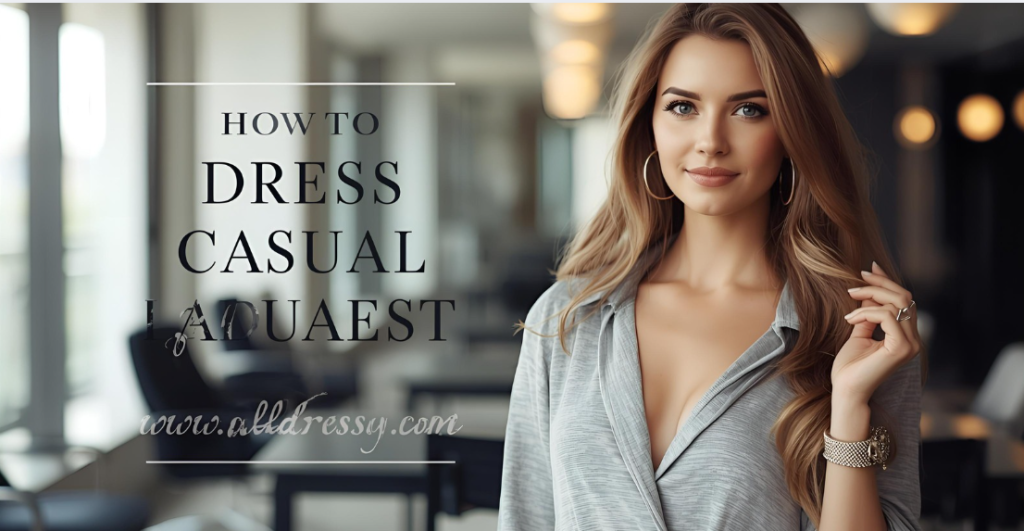Navigating the world of business casual for ladies can often feel like deciphering a complex code. It’s a dress code that sits in the crucial space between the formality of traditional suits and the relaxed nature of casual wear. For many professional women, this ambiguity leads to morning closet frustration and uncertainty about what is truly appropriate. However, mastering how to dress business casual for ladies is one of the most powerful skills you can develop for your career. It’s a non-verbal communication tool that signals competence, credibility, and confidence. This comprehensive guide will demystify the business casual dress code, providing you with a clear, actionable framework to build a versatile, polished, and professional wardrobe that makes getting dressed each morning a seamless and empowering experience.
Why Mastering Business Casual for Ladies Matters More Than You Think

Your professional appearance is the first thing colleagues and clients notice, and it sets the tone for all interactions that follow. Dressing appropriately within the business casual framework is not about vanity; it’s about strategy. A well-curated business casual wardrobe:
- Builds Instant Credibility: It positions you as a serious professional who pays attention to detail, making it easier to command respect in meetings and presentations.
- Boosts Self-Confidence: When you know you look polished and appropriate, you carry yourself with greater assurance, which positively impacts your performance and communication.
- Offers Versatility and Comfort: Unlike a strict formal dress code, business casual allows for more personal expression and often incorporates more comfortable fabrics and silhouettes, enabling you to move through your day with ease.
- Adapts to Modern Workplaces: As offices become more flexible and hybrid, the business casual dress code has become the universal standard for industries from tech and creative fields to finance and healthcare (in administrative roles).
Decoding the Dress Code: What “Business Casual for Ladies” Really Means

The term “business casual” is often the most confusing because it varies by company, industry, and even region. At its core, it means looking professional and put-together without being overly formal. Think of it as “polished professional.” You are subtracting the strict structure of a full matching suit but adding intentional, sophisticated pieces.
Key Hallmarks of a Business Casual Outfit:
- Tailored Silhouettes: Clothing should be well-fitted but not tight. Think blazers that skim your body, trousers that are hemmed to the right length, and tops that are neat and tidy.
- High-Quality Fabrics: Opt for materials that look rich and hold their shape, such as ponte knit, wool blends, thick cotton, silk, and structured synthetics. Avoid overly casual fabrics like thin jersey, denim, or loud spandex.
- Moderate Hemlines and Necklines: Skirts and dresses should generally be at or near the knee. Necklines should not be overly revealing; a classic crewneck, V-neck, or boat neck is ideal.
- Closed-Toe Shoes: While this is evolving, closed-toe shoes in leather or suede (pumps, loafers, elegant flats) are traditionally the safest and most polished option.
The Foundation of Your Wardrobe: Core Business Casual Pieces for Ladies
Building a versatile business casual wardrobe is not about having a closet full of clothes; it’s about having the right clothes that can be mixed and matched endlessly. Here are the essential building blocks.
1. The Indispensable Tops
Your tops are the workhorses of your wardrobe and set the tone for your outfit.
- The Classic Blouse: A well-fitting blouse in silk, satin, or a high-quality polyester blend is a cornerstone. Look for styles like a button-down (ensure it doesn’t gape), a elegant tie-neck, or a simple shell top. Neutral colors like white, ivory, light blue, and black are most versatile.
- The Structured Knit Top: A top made of a substantial knit like ponte or double-knit cotton offers the comfort of a sweater with the polish of a blouse. A simple long-sleeve top in a solid color can be worn under everything.
- The Sophisticated Sweater: Fine-gauge sweaters in merino wool or cashmere blends are perfect for layering. A V-neck or crewneck sweater over a collared shirt or alone projects intelligence and ease.
2. The Essential Bottoms
Your choice of bottoms provides the foundation for your entire look.
- The Perfect Trousers: Every woman needs a few pairs of excellent trousers. Key styles include:
- Straight-Leg or Wide-Leg Trousers: A modern, chic option that is both comfortable and powerful.
- Ponte Knit Pants: The ultimate combination of comfort and polish, with enough structure to look professional.
- Cropped/Ankle-Length Trousers: Ideal for showcasing a great pair of shoes. Ensure the hem hits at the slimmest part of your ankle.
- The Versatile Skirt: A pencil skirt that hits at the knee is a timeless classic. An A-line skirt in a neutral fabric is another flattering and professional option.
3. The Power of Layers: Blazers and Jackets
Layers are the secret weapon in mastering how to dress business casual for ladies. They instantly pull an outfit together and add a layer of authority.
- The Unstructured Blazer: This is a softer alternative to a traditional suit blazer. It often lacks shoulder pads and internal structuring, making it more comfortable for all-day wear while still looking sharp.
- The Cardigan Jacket: A long, structured cardigan that mimics the cut of a blazer is a fantastic, modern layering piece. It provides warmth and polish without feeling too formal.
- The Classic Blazer: A well-tailored, traditional blazer in navy, black, or grey is a wardrobe powerhouse that can be thrown over any outfit for an instant upgrade.
4. The Go-To Dresses
A dress is the ultimate one-and-done outfit, making mornings effortless.
- The Sheath Dress: This is the business casual equivalent of the little black dress. A sheath dress in a ponte knit or wool blend is universally flattering and profoundly professional. It can be worn alone or with a blazer.
- The Shirt Dress: A crisp, tailored shirt dress that belts at the waist is a chic and comfortable option. Ensure the length is appropriate and the fabric is not too casual like linen or denim.
5. The Finishing Touch: Footwear
Your shoes can make or break an outfit. The goal is a balance of style and practicality.
- Pumps: A classic pump with a low to medium heel (1.5 – 3 inches) in a neutral color (black, navy, nude) is a timeless choice.
- Loafers & Flats: Elegant ballet flats or sophisticated leather loafers are perfect for days spent on your feet while maintaining a polished look.
- Block Heels & Elegant Boots: A block heel offers stability and modern style. In colder months, a sleek, knee-high or ankle boot with a minimal design is perfectly acceptable.
The Art of Coordination: Creating Cohesive Business Casual Outfits
With your core pieces in place, the next step is learning to combine them. The most effective business casual wardrobes are built on a cohesive color palette.
Building a Color Strategy:
- Start with Neutrals: Build the foundation of your wardrobe around core neutrals: black, navy, grey, camel, and white. These colors mix and match seamlessly.
- Add Accent Colors: Introduce a few seasonal or personal accent colors to add interest. Rich jewel tones like emerald green, burgundy, and sapphire blue are excellent for professional settings. Softer tones like blush pink or lavender can also work when paired with strong neutrals.
- Incorporate Pattern Carefully: Patterns are welcome but should be worn strategically. A subtle pinstripe, a classic houndstooth, or a modest floral can add personality. The key is to balance them with solid pieces. For example, pair a patterned blouse with solid trousers, or a patterned skirt with a solid top.
Advanced Styling: How to Accessorize Your Business Casual Look
Accessories are the punctuation marks of your outfit—they complete the sentence. The rule for business casual is to keep it elegant and uncluttered.
- Jewelry: Opt for simple, classic pieces. Stud earrings, a delicate necklace, a simple watch, and a few thin bangles are perfect. Avoid noisy, oversized, or overly trendy costume jewelry.
- Bags: Your work bag should be structured and professional. A leather tote, satchel, or structured crossbody bag in a neutral color is ideal. It should be large enough to hold a laptop or files but remain sleek.
- Belts: A simple leather belt that matches your shoes can help define your waist and pull an outfit together.
- Scarves: A silk or fine knit scarf can add a pop of color and sophistication to a neutral outfit.
Navigating Nuances: Industry Variations and Common Pitfalls
The interpretation of business casual can lean more “business” or more “casual” depending on your workplace.
- Conservative Fields (Law, Finance, Corporate): Lean towards the more formal end of the spectrum. Prioritize tailored trousers, blazers, sheath dresses, and closed-toe pumps. Patterns should be very subtle.
- Creative & Tech Industries: You have more flexibility. You might incorporate dark, well-fitted denim (if company policy allows), more bold colors and patterns, and fashionable sneakers. However, the “polished” element must remain—clothes should still be intentional and neat.
Common Pitfalls to Avoid:
- Overly Casual Items: Avoid wearing yoga pants, leggings as pants, spaghetti straps, sheer tops, shorts, or flip-flops.
- Wrinkled or Ill-Fitting Clothes: Nothing undermines a professional look faster than clothes that are wrinkled, stained, or poorly fitted.
- Too Much Fragrance: Scent is a powerful accessory. Keep it minimal to avoid offending colleagues in close quarters.
Building a Budget-Conscious Business Casual Wardrobe
Looking professional doesn’t require a massive budget. It requires a smart, strategic approach.
- Invest in the Core: Spend more on items you’ll wear constantly—a great blazer, a perfect pair of trousers, a quality handbag, and comfortable, durable shoes. These “anchor” pieces are worth the investment.
- Save on Trend-Based Items: Buy trendier pieces like statement blouses or colorful accessories at more affordable retailers.
- Embrace the Capsule Wardrobe Mentality: Focus on acquiring versatile, mix-and-match pieces in a coordinated color palette. Ten well-chosen items can create far more outfits than thirty random ones.
Frequently Asked Questions (FAQs)
Q1: Can I wear jeans in a business casual setting?
This is highly company-specific. In more traditional offices, the answer is typically no. In modern or creative workplaces, a dark wash, well-fitting pair of jeans with no rips or distressing can sometimes be acceptable if paired with very polished elements, like a blazer, a silk blouse, and elegant loafers or heels. Always observe what senior leadership wears first.
Q2: Are sleeveless tops and dresses allowed?
Yes, but with strategic layering. A sleeveless sheath dress or a shell top is perfectly fine, but it should be covered with a blazer or cardigan jacket when in meetings or common areas. Avoid spaghetti straps or anything that looks like a tank top meant for the gym.
Q3: How can I express my personal style within business casual constraints?
Your personal style shines through in the details. This is where your choice of color, pattern, accessories, and the specific silhouettes you prefer (e.g., A-line vs. pencil skirt) come into play. A unique piece of statement jewelry, a colorful scarf, or a fashionable pair of glasses can all inject personality into a classic outfit.
Q4: What are the best fabrics to look for that are both comfortable and professional?
Ponte knit is a superstar fabric for business casual wear—it’s stretchy, comfortable, holds its shape, and resists wrinkles. Other excellent choices include wool blends, thick cotton twill, silk, and high-quality synthetic blends that mimic natural fibers.
Q5: Is it okay to wear open-toed shoes?
In many modern offices, yes. However, the style is critical. Avoid flip-flops, beach sandals, or anything with a very high, strappy heel. An elegant, structured sandal with a block heel or a peep-toe pump in a neutral color is generally acceptable during warmer months. When in doubt, opt for closed-toe.
Q6: How many core pieces do I need to get started?
You can build a remarkably versatile foundation with just a few key items:
- 2 pairs of trousers (e.g., black ponte, navy tailored)
- 1 skirt (e.g., a grey pencil skirt)
- 1-2 blazers (e.g., navy and black)
- 3-5 tops (a mix of blouses and knit tops)
- 1 sheath dress
- 2-3 pairs of shoes (e.g., black pumps, nude loafers, ankle boots)
Conclusion: Your Journey to Mastering Business Casual Starts Now
Mastering how to dress business casual for ladies is an investment in your professional identity. It is a journey of understanding the unspoken rules of your workplace, honing your personal style within those parameters, and building a wardrobe that works as hard as you do. By focusing on fit, fabric, and versatile core pieces, you can eliminate daily stress and project an image of unwavering confidence and competence.
Remember, the goal is not to look like everyone else, but to look like the best, most professional version of yourself. Start by auditing your current wardrobe, identify the gaps, and make one strategic purchase at a time. With this guide as your roadmap, you are well-equipped to navigate the world of business casual with ease, style, and undeniable confidence.

